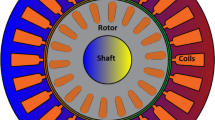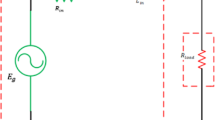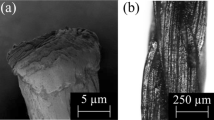Abstract
The ability to predict the thermal transport properties of electrical, electronic, and mechanical components becomes increasingly important as characteristic material sizes shrink to the micron and nanometre scale. The maximum hot-spot temperature is one of the thermal and electrical efficiency design constraints. In this paper, the thermal analysis of a three-phase induction machine is investigated by means of replacing the winding materials. The temperature distribution is evaluated from a two-dimensional finite element approach, using COMSOL Multiphysics software. The temperature rise has been analyzed when conventional winding materials are substituted by novel nanomaterials, namely, carbon nanotube, carbon nanotube aluminum, and carbon nanotube copper composite wires. Overall, the proposed model with carbon nanotube copper composite wire winding machine shows better thermal performance among the studied carbon-based winding materials. Thus, we conclude that the carbon nano-based materials for thermal management in electrical machine winding provide a viable and effective alternative to existing materials.




















Similar content being viewed by others
References
Liu P, Fan Z, Mikhalchan A, Tran TQ, Jewell D, Duong HM, Marconnet AM (2016) Continuous carbon nanotube-based fibers and films for applications requiring enhanced heat dissipation. ACS Appl Mater Interfaces 8(27):17461–17471
Ruehli AE, Antonini G, Jiang LJ (2012) Skin-effect loss models for time-and frequency-domain PEEC solver. Proc IEEE 101(2):451–472
Koziol K, Vilatela J, Moisala A, Motta M, Cunniff P, Sennett M, Windle A (2007) High-performance carbon nanotube fiber. Science 318(5858):1892–1895
Hong S, Myung S (2007) A flexible approach to mobility. Nat Nanotechnol 2(4):207–208
Lekawa-Raus A, Patmore J, Kurzepa L, Bulmer J, Koziol K (2014) Electrical properties of carbon nanotube based fibers and their future use in electrical wiring. Adv Funct Mater 24(24):3661–3682
Zhang S, Nguyen N, Leonhardt B, Jolowsky C, Hao A, Park JG, Liang R (2019) Carbon-nanotube-based electrical conductors: fabrication, optimization, and applications. Adv Electron Mater 5(6):1800811
Miao M (2013) Yarn spun from carbon nanotube forests: production, structure, properties and applications. Particuology 11(4):378–393
Yadav MD, Dasgupta K, Patwardhan AW, Joshi JB (2017) High performance fibers from carbon nanotubes: synthesis, characterization, and applications in composites—a review. Ind Eng Chem Res 56(44):12407–12437
Cesano F, Uddin MJ, Lozano K, Zanetti M, Scarano D (2020) All-carbon conductors for electronic and electrical wiring applications. Front Mater 7:219
Kurzepa L, Lekawa-Raus A, Patmore J, Koziol K (2014) Replacing copper wires with carbon nanotube wires in electrical transformers. Adv Funct Mater 24(5):619–624
Pyrhönen J, Montonen J, Lindh P, Vauterin J, Otto M (2015) Replacing copper with new carbon nanomaterials in electrical machine windings. Int Rev Electr Eng (IREE) 10(1). https://doi.org/10.15866/iree.v10i1.5253
Jang Y, Kim SM, Spinks GM, Kim SJ (2020) Carbon nanotube yarn for fiber-shaped electrical sensors, actuators, and energy storage for smart systems. Adv Mater 32(5):1902670
COMSOL Multiphysics 5.4 AC/DC module user’s guide, 2018
Todorov M, Streblau M, Marinov M (2020) An approach for investigation of the temperature field in a three-phase asynchronous motor. In: 2020 21st international symposium on electrical apparatus and technologies (SIELA). IEEE, pp 1–5
Todorov M, Streblau M, Marinov M, Dimova T (2021) Analysis of the transient process in a direct start-up of an induction motor, by use of COMSOL Multiphysics. In: 2021 International Conference Automatics and Informatics (ICAI), pp 406–409. IEEE
Vollebregt S, Banerjee S, Beenakker K, Ishihara R (2013) Size-dependent effects on the temperature coefficient of resistance of carbon nanotube vias. IEEE Trans Electron Devices 60(12):4085–4089
Khan ZH, Husain S, Husain M (2010) Variable range hopping in carbon nanotubes. Curr Nanosci 6(6):626–641
Raphey VR, Henna TK, Nivitha KP, Mufeedha P, Sabu C, Pramod K (2019) Advanced biomedical applications of carbon nanotube. Mater Sci Eng C 100:616–630
Randeniya LK, Bendavid A, Martin PJ, Tran C-D (2010) Composite yarns of multiwalled carbon nanotubes with metallic electrical conductivity. Small 6(16):1806–1811
Shang Y, Wang Y, Li S, Hua C, Zou M, Cao A (2017) High-strength carbon nanotube fibers by twist-induced self-strengthening. Carbon 119:47–55
Behabtu N, Young CC, Tsentalovich DE, Kleinerman O, Wang X, Ma AWK, Bengio EA et al (2013) Strong, light, multifunctional fibers of carbon nanotubes with ultrahigh conductivity. Science 339(6116):182–186
Shin SE, Choi HJ, Bae DH (2013) Electrical and thermal conductivities of aluminum-based composites containing multi-walled carbon nanotubes. J Compos Mater 47(18):2249–2256
Cha SI, Kim KT, Arshad SN, Mo CB, Hong SH (2005) Extraordinary strengthening effect of carbon nanotubes in metal-matrix nanocomposites processed by molecular-level mixing. Adv Mater 17(11):1377–1381
Mohammed SMAK, Chen DL (2020) Carbon nanotube-reinforced aluminum matrix composites. Adv Eng Mater 22(4):1901176
Janas D, Liszka B (2018) Copper matrix nanocomposites based on carbon nanotubes or graphene. Mater Chem Front 2(1):22–35
Sundaram RM, Sekiguchi A, Sekiya M, Yamada T, Hata K (2018) Copper/carbon nanotube composites: research trends and outlook. Roy Soc Open Sci 5(11):180814
Subramaniam C, Yamada T, Kobashi K, Sekiguchi A, Futaba DN, Yumura M, Hata K (2013) One hundred fold increase in current carrying capacity in a carbon nanotube-coppercomposite. Nat Commun 4:2202
Wang X, Behabtu N, Young CC, Tsentalovich DE, Pasquali M, Kono J (2014) High-ampacity power cables of tightly-packed and aligned carbon nanotubes. Adv Funct Mater 24(21):3241–3249
Mezani S, Takorabet N, Laporte B (2005) A combined electromagnetic and thermal analysis of induction motors. IEEE Trans Magn 41(5):1572–1575
Ahmed F, Kar NC (2017) Analysis of end-winding thermal effects in a totally enclosed fan-cooled induction motor with a die cast copper rotor. In: IEEE transactions on industry applications, vol 53, no 3, pp 3098–3109
Acknowledgements
This work was financially supported by SWJTU’s foundation, and the first author was financially supported by the CSC Fellowship.
Funding
This work was financially supported by SWJTU’s foundation, and the first author was also financially supported by the CSC Fellowship.
Author information
Authors and Affiliations
Corresponding authors
Ethics declarations
Conflict of interest
The authors declare that they have no conficts of interest to report regarding the present study.
Additional information
Publisher's Note
Springer Nature remains neutral with regard to jurisdictional claims in published maps and institutional affiliations.
Rights and permissions
About this article
Cite this article
Hassan, A., Quanfang, C., Abbas, S. et al. Comparative Thermal Analysis of Carbon Nanotubes and Their Metal Composites with Copper and Aluminum as Winding Material in Induction Motor. J. Electr. Eng. Technol. 17, 2353–2365 (2022). https://doi.org/10.1007/s42835-022-01072-9
Received:
Revised:
Accepted:
Published:
Issue Date:
DOI: https://doi.org/10.1007/s42835-022-01072-9




